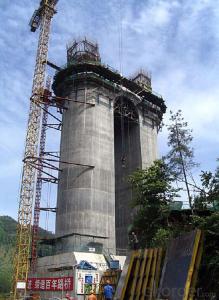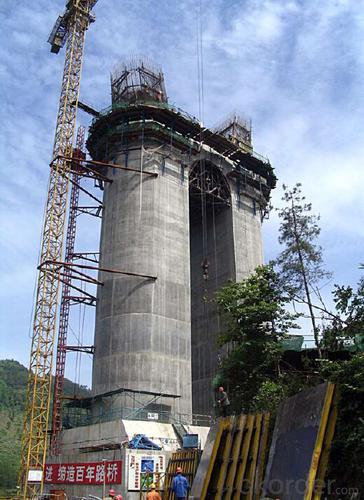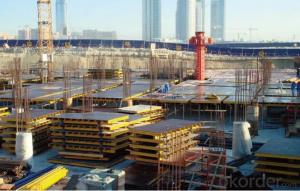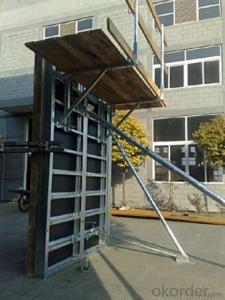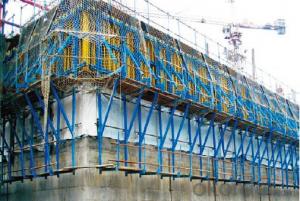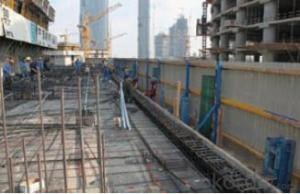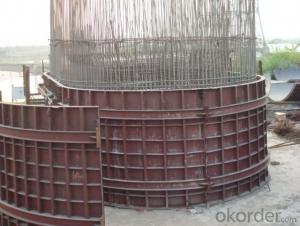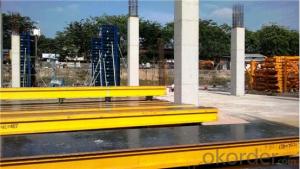Auto-climbing Bracket ACB100 & ACB50 for formwork and scaffolding systems
- Loading Port:
- Tianjin
- Payment Terms:
- TT OR LC
- Min Order Qty:
- 50 m²
- Supply Capability:
- 1000 m²/month
OKorder Service Pledge
OKorder Financial Service
You Might Also Like
Auto-climbing Bracket ACB100 & ACB50
The power of the auto-climbing formwork is the hydraulic system, which includes the oil cylinder
and two commutators. The commutators can control the climbing of climbing rail and the bracket.
The steel rail and the bracket can inter-climbing, so the whole system will climb up steadily.
Cranes are not needed during the construction. It’s easy to operate, highly efficient and safe. It’s
the best choice for the construction of high buildings and bridges.
There are mainly two types of standard auto-climbing brackets, ACB-50 and ACB-100, the figure
means the push power of cylinder with unit of KN.
Characteristics:
◆ Perfect load bearing anchor system
Anchor system is the most important supporting part. The system is made of five parts shown
below. Thereinto, tensile bolt, V-climbing cone and washer can be taken out for reusing after the
concrete pouring finished.There are two kinds of anchor systems,A & B. A is matched with single
anchor shoe and B is matched with double anchor shoe.
◆ Crane-independent
Crane-independent forming, striking and climbing speeds up the work procedures on the
construction site and also makes them independent of each other. This means the planned
sequences can be maintained along with guaranteeing high productivity levels. The crane can
therefore be used for other tasks.
Hydraulic system is mainly made of two commutators,
oil cylinder and power distribution system.The
commutators can control the climbing of climbing rail
and bracket.
◆ High bearing capacity and safe
The stable working platforms are able to carry large loads, e.g. the storage of reinforcing steel
for the next climbing section. Generously-sized working platforms, the well thought-out design for
handling very high wind loads and the patented control function of the climbing mechanism are
some of the special details contained within the comprehensive safety concept.
◆ Platforms adjusted to suit the angle of inclination
The horizontal working areas thus created provide safe and comfortable conditions for
reinforcement work, shuttering and striking, concreting and finishing.
◆ The ACB formwork system can climb not only vertically but also slantways, the largest angle is
18 degrees.
◆ The system can climb up wholly or separately. The climbing process is steady, synchronous
and safe.
◆ The bracket will not fall to the ground until the construction is finished, the field will be saved
and the impacting breakage will be reduced (especially the panel).
◆ The system will furnish omnidirectional platform, the construction organizations don’t need to
set up additional operation platform.
◆ The error of structure construction is small and easy to correct.
◆ The climbing speed is fast, the construction course will be quickened.
◆ The formwork can climb itself and cleaning work can be done in the same situs , the used times
of tower crane will be greatly reduced.
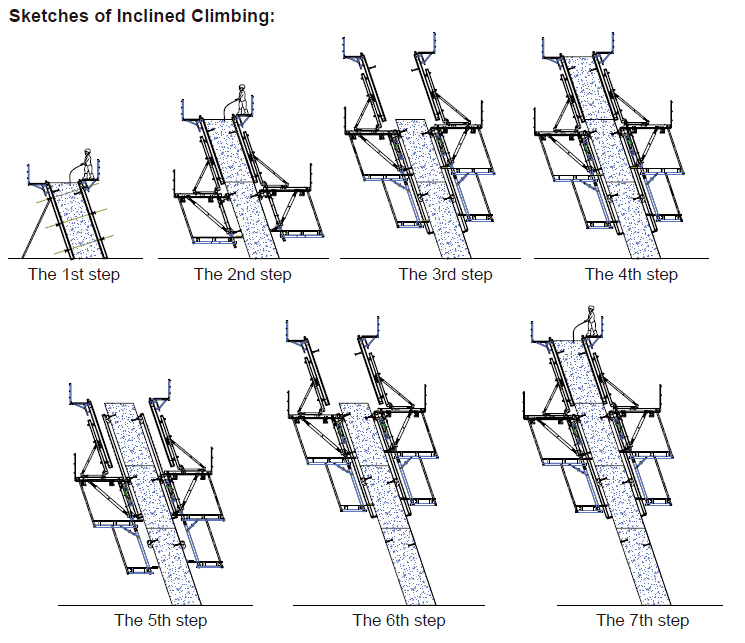
- Q: What types of structures can be built using steel formwork?
- Steel formwork, a versatile construction technique, enables the construction of diverse structures. Examples of structures that can be built using steel formwork include: 1. Buildings: Residential, commercial, and industrial buildings commonly utilize steel formwork. This method provides a robust and durable framework for pouring concrete, ensuring the structural integrity of the building. 2. Bridges: Steel formwork is extensively employed in bridge construction due to its exceptional strength and load-bearing capacity. It allows for the creation of intricate bridge structures, including arches, beams, and deck slabs. 3. Tunnels: Steel formwork is also utilized in tunnel construction to provide a temporary framework for the concrete lining. Whether for road, rail, or utility tunnels, steel formwork guarantees the stability and durability of the tunnel structure. 4. Water-retaining structures: Steel formwork is suitable for constructing water-retaining structures like tanks, dams, and reservoirs. It can withstand the water pressure and create a watertight seal, ensuring the safe storage or containment of water. 5. Silos: Steel formwork is commonly used in the construction of silos for storing bulk materials such as grain, cement, or chemicals. It offers the necessary strength and stability to endure the weight and pressure of the stored materials. 6. Industrial structures: Steel formwork finds extensive use in the construction of industrial structures such as factories, warehouses, and power plants. It provides a rigid framework capable of supporting heavy machinery and equipment, ensuring the safe operation of these facilities. 7. Retaining walls: Steel formwork is often utilized in the construction of retaining walls, which serve to hold back soil or other materials. It provides a durable and stable structure capable of withstanding the lateral pressure exerted by the retained material. In summary, the versatility and strength of steel formwork make it well-suited for a wide range of construction applications. It enables efficient and cost-effective construction of various structures while ensuring their durability and stability.
- Q: Can steel formwork be used for suspended slabs?
- Indeed, suspended slabs can utilize steel formwork. This adaptable and resilient material proves instrumental in furnishing the required support and structure for such slabs. Notably, steel formwork boasts attributes such as longevity, reusability, and design flexibility, rendering it a desirable choice. Its effortless assembly and disassembly further make it an ideal option for suspended slab construction, where formwork relocation or adjustment is necessary. Moreover, steel formwork yields a sleek and refined surface for the slab, thus minimizing the necessity for supplementary finishing tasks.
- Q: How does steel formwork contribute to the overall strength of the structure?
- Steel formwork contributes to the overall strength of a structure by providing a rigid framework that supports the weight of the concrete during construction. The steel panels and supports are able to withstand the pressure and forces exerted by the wet concrete, ensuring that it is evenly distributed and properly cured. This results in a more durable and structurally sound building, with increased load-bearing capacity and resistance to external factors such as wind, earthquakes, and other environmental stresses.
- Q: I would like to ask, large steel formwork and the average number of square meters of a template?
- Single wage calculation, 9000 flat template assembly line
- Q: Can steel formwork be used for precast concrete elements?
- Indeed, precast concrete elements can be constructed using steel formwork. The utilization of steel formwork in precast concrete fabrication is widely favored due to its robustness and ability to be reused. It creates a sturdy and inflexible framework capable of withstanding the force exerted by liquid concrete during casting and the load of solidified concrete after curing. Moreover, steel formwork guarantees a uniform and polished appearance for the precast elements, ensuring impeccable and accurate outcomes. Furthermore, the assembly and disassembly of steel formwork is effortless, enabling efficient manufacturing and convenient transportation of precast elements.
- Q: How does steel formwork affect the overall dimensional stability of a structure?
- The overall dimensional stability of a structure can be significantly improved by using steel formwork. Steel formwork is known for its strength and rigidity, which makes it an excellent support system during construction. This ensures that the concrete is accurately and precisely placed, resulting in a structure with enhanced dimensional stability. There are several advantages to using steel formwork that contribute to its overall dimensional stability. Firstly, steel has a high strength-to-weight ratio, allowing for the creation of strong and durable formwork systems. This strength prevents any shifts or movements in the formwork during concrete pouring, reducing the likelihood of dimensional changes in the final structure. Furthermore, steel formwork offers superior dimensional accuracy compared to other materials. The steel plates or panels used in the formwork can be manufactured with high precision, resulting in consistent dimensions and smooth surfaces. This eliminates any inconsistencies or irregularities that may occur with traditional formwork materials like wood or plywood, further enhancing the overall dimensional stability. In addition, steel formwork is highly resistant to moisture, humidity, and temperature variations, which can cause dimensional changes in other materials. This resistance ensures that the formwork remains stable and maintains its original shape, even in challenging environmental conditions. The stability extends to the concrete poured within the formwork, as the steel helps to minimize shrinkage and expansion, reducing the risk of cracks or warping in the structure. In conclusion, steel formwork is essential for maintaining the overall dimensional stability of a structure. Its strength, precision, and resistance to environmental factors ensure that the formwork remains intact and accurately supports the concrete placement. By providing a reliable and robust framework, steel formwork allows for the creation of structures with enhanced dimensional stability, resulting in a long-lasting and durable final product.
- Q: What are the different types of steel formwork?
- There are several different types of steel formwork used in construction projects. These include: 1. Traditional steel formwork: This type of formwork is made from steel plates and angles, and it is commonly used for simple structures or where the formwork needs to be reused multiple times. Traditional steel formwork is durable and can withstand heavy loads, but it can be time-consuming to set up and dismantle. 2. Modular steel formwork: This formwork system consists of prefabricated modules that can be easily assembled and disassembled on-site. It is highly versatile and can be used for a wide range of structures, including walls, columns, and slabs. Modular steel formwork is lightweight and easy to handle, reducing labor costs and construction time. 3. Tunnel formwork: This type of formwork is specifically designed for constructing tunnel structures. It consists of steel panels that are bolted together to create a continuous formwork system. Tunnel formwork is efficient and allows for rapid construction, making it suitable for large-scale projects such as subway tunnels or underground structures. 4. Slip formwork: Slip formwork is a method where a continuous concrete pour is used to create a vertical structure, such as a tower or chimney. Steel formwork is used to create the initial mold, which is continuously moved upward as the concrete is poured. Slip formwork allows for fast construction and is commonly used for high-rise buildings or structures with a consistent cross-section. 5. Climbing formwork: This formwork system is used for constructing tall vertical structures, such as skyscrapers or bridge piers. Steel formwork is attached to the structure and then hydraulically lifted or climbed as the construction progresses. Climbing formwork allows for continuous construction and eliminates the need for external scaffolding. Each type of steel formwork has its advantages and disadvantages, and the choice depends on the specific requirements of the project, including budget, construction time, and complexity.
- Q: How does steel formwork contribute to better site organization?
- Steel formwork contributes to better site organization by providing a durable and reusable system for creating concrete structures. Its accuracy, strength, and ease of assembly allow for efficient and precise construction, reducing the need for on-site adjustments or modifications. This results in a well-organized and streamlined construction process, saving time and resources. Additionally, steel formwork's versatility enables the creation of complex shapes and designs, enhancing the aesthetic appeal of the site.
- Q: What are the different types of release agents used with steel formwork?
- There are several different types of release agents that can be used with steel formwork. Some of the most common types include: 1. Water-based release agents: These types of release agents are composed primarily of water, with additives such as surfactants and lubricants. They are environmentally friendly and easy to apply, typically by spraying or brushing onto the steel formwork. Water-based release agents form a thin film on the surface of the steel, preventing adhesion of the concrete during the curing process. 2. Solvent-based release agents: Solvent-based release agents use organic solvents as the carrier for the active ingredients. They are effective in providing a smooth surface finish on the concrete and are often used in situations where a higher level of release performance is required. Solvent-based release agents are typically applied by spraying or brushing and evaporate quickly, leaving a thin film on the steel formwork. 3. Barrier release agents: Barrier release agents are typically applied as a thick paste or gel and provide a physical barrier between the steel formwork and the concrete. They are often used in situations where a high-quality surface finish is required, such as architectural concrete applications. Barrier release agents can be applied by brushing or troweling onto the steel formwork. 4. Dry release agents: Dry release agents are powdered or granular materials that are applied directly to the steel formwork. They create a non-stick surface by absorbing excess moisture from the concrete, preventing adhesion. Dry release agents are commonly used in situations where other types of release agents may not be suitable, such as in cold weather conditions. 5. Form release oils: Form release oils are petroleum-based products that are commonly used with steel formwork. They provide an effective release barrier between the steel and the concrete, preventing adhesion. Form release oils are typically applied by spraying or brushing onto the steel formwork and can be used in a variety of concrete applications. It is important to select the appropriate type of release agent based on the specific requirements of the project, including the desired surface finish, environmental considerations, and ease of application. Consulting with a professional or manufacturer's recommendations can help determine the most suitable release agent for a particular steel formwork application.
- Q: How does steel formwork compare to plywood formwork?
- Steel formwork is generally considered to be more durable and long-lasting compared to plywood formwork. Steel formwork can withstand higher levels of pressure, making it suitable for heavy-duty construction projects. Additionally, steel formwork offers greater dimensional accuracy and stability, resulting in fewer defects in the final concrete structure. While plywood formwork may be more cost-effective in certain scenarios, steel formwork is often preferred for its strength, durability, and ability to be reused multiple times, making it a more sustainable option in the long run.
Send your message to us
Auto-climbing Bracket ACB100 & ACB50 for formwork and scaffolding systems
- Loading Port:
- Tianjin
- Payment Terms:
- TT OR LC
- Min Order Qty:
- 50 m²
- Supply Capability:
- 1000 m²/month
OKorder Service Pledge
OKorder Financial Service
Similar products
Hot products
Hot Searches
